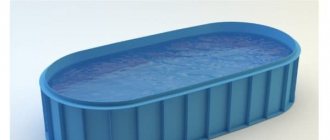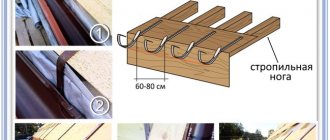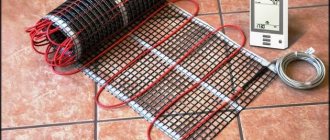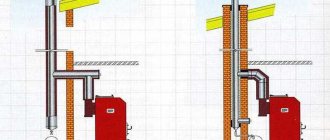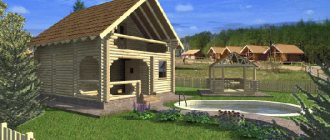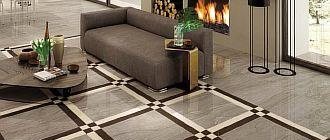The service life of a drainage system in a private home depends on the material from which it is made and the correct installation.
To understand which drain is better, plastic or metal, you need to compare the characteristics of products from well-known brands. Each type of gutters has its own advantages and disadvantages, as well as adherents among builders.
depositphotos
About comparison of metal drainage systems
There is no point in comparing copper or titanium-zinc gutters with systems made from other materials. This is an elite group that is distinguished not only by its cost, but also by its almost unlimited service life.
Of course, they have some limit, but gutters and funnels made of non-ferrous metals will last longer than the roof rafter system or the front boards of the eaves to which they are attached.
On the other hand, despite their exclusivity, copper and titanium-zinc gutters have a limited choice of colors. They are not painted, and in addition to the “natural” one, there is a patinated or artificially oxidized metal surface. And these are two additional “antique” shades.
It is also necessary to “weed out” gutters made of alloy steel (stainless steel). Such systems are used extremely rarely - they are not produced on an industrial scale, but are made to order by metalworking companies.
And there are two types of metal for drainage - galvanized steel and aluminum. Both options have approximately the same cost (within the same order of magnitude), they are painted in similar RAL colors, they have similar decorative capabilities and comparable service life.
So what should you choose?
The question of whether plastic or metal gutters are better can get quite complicated. And to solve it, one cannot do without taking into account some factors, the most important of which are usually price and durability.
The most practical choice is considered to be one in which the service life of the gutter and roof are the same. That is, the replacement of the drain occurs simultaneously with the reconstruction of the roof. As for price, the cheapest are plastic and galvanized gutters, and the most expensive are copper and titanium-zinc.
You need to focus on your wallet. However, even by choosing the cheapest gutters, you can significantly extend the guaranteed service life by properly caring for the products and carrying out repair work on time.
Appearance
Externally, metal and plastic gutters are practically the same. The most common systems are those with “round” shapes of pipes and gutters. Some manufacturers additionally produce “oval” gutters, which have a greater throughput than round ones.
If the architectural style of the building presupposes the dominance of straight lines, then you will have to choose a steel drain - only it has rectangular profiles. And perhaps this is the only difference between the decorative capabilities of the two materials of drainage systems.
Each manufacturer's metal or plastic drain has a standard color palette, which ranges from three to seven shades.
The minimum set is white, dark gray (or dark brown), brick. The first two colors are neutral, and each of them will harmoniously fit into either a light or dark façade finish. Each of them has other shades, but they also belong to the traditional ones - red, green, black.
Steel gutters have a slight advantage - varying degrees of gloss. The galvanized profile has the same polymer protective and decorative layer as metal tiles. And her polyester or pural can be either glossy or matte.
Features of choosing a drain for your home
One of the main reasons for the destruction of facades and plinths of buildings is water.
In the absence of drainage, water in the cold season, falling on the walls, is partially absorbed and freezes, expands and gradually causes destruction. For a brick wall, the penetration of moisture into the seams is detrimental; this significantly reduces the strength of the masonry; microcracks may appear in plastered facades, which will grow over time and lead to peeling. In buildings without a blind area, chaotic water flow from the roof can lead to erosion of the foundation and sagging of the entire house. Even extended roof overhangs cannot completely prevent getting wet. Melt and rainwater, falling under the foundation of a house, can accumulate under it or in the basement of the building, contributing to an increase in humidity in the basement and basement and the destruction of the floor joists of the first floor.
For the owner of a new cottage who does not want to face such troubles, installing the system is a mandatory stage of construction. A drainage system is necessary for the organized collection of water from the roof and its removal from the facades and blind areas. In addition, modern drainage systems have certain aesthetic qualities that decorate the house and give it a finished look.
All drainage systems have a common operating principle, but differ in material, shape and installation method. Which gutters to choose for your roof? The main feature by which drainage systems are classified is the material from which they are made, which also determines the characteristics of the drainage system.
There are two types of modern systems:
- plastic (polymer) - made of polyvinyl chloride (PVC);
- metal - steel, aluminum, aluzinc, copper, etc.
Life time
Everyone's warranty requirements are different. Even companies that produce gutters from the same materials formulate their obligations in their own way.
The minimum warranty period is 10 years. And only steel gutters have it. Moreover, in some cases it can be reduced if we are talking about the sea coast (at a distance of up to 3 km from the sea).
For example, Aquasystem's drainage warranty is reduced to 7 years. Ruukki gutters guarantee 20 years without the appearance of through corrosion. The twofold difference in characteristics is explained by different coating materials.
Plastic gutters are not so capricious. The minimum warranty period is 15 years (TechnoNikol), the maximum is 25 years (German Döcke, made in Russia). But the actual service life, according to manufacturers, is at least 50 years.
There is no doubt about the reality of the stated figures (if we are talking about “branded” products) - vinyl siding experiences the same loads and lasts for many years.
The “intermediate” position is occupied by aluminum gutters with a powder paint coating. For example, the Linkor company guarantees 30 years of service for its drainage system. But only if the house is located more than 3 km from the seashore (otherwise the warranty is 10 years).
FLOPLAST
English manufacturing company opened in 1991. The company's products are in great demand on the world market. Floplast's assortment includes drainage and drainage systems made of high-quality plastic. The manufacturer offers a wide selection of reliable designs that are easy to assemble and quick to install. The components of drainage systems are designed in such a way that they can be installed on a roof of any configuration and with any type of roofing.
Durability and reliability
In this case, two types of influence must be considered.
Structural strength, or resistance to mechanical deformation
Steel has higher strength than plastic. Plastic is more fragile, and this is reflected in the installation requirements - hooks for gutters must be installed more often.
In addition, polymers, like any organic materials, are “stable” over a narrow temperature range. The addition of thermal stabilizers expands it, but with prolonged exposure to high or low temperatures, the plastic softens or becomes brittle. Therefore, it equally does not tolerate heat and heavy ice in severe frosts.
Ice can be dealt with, but if a plastic drain is located on the south side of the house and is exposed to the sun, then its surface can heat up above the +50°C prescribed by the manufacturer. There are no such restrictions for steel, although polymer coatings for metal drains have different UV resistance.
The advantage of polymer drainage is the “shape memory” effect. When water freezes in the gutter, it becomes deformed, but after the ice melts, the profile will return to its original state.
Resistance to mechanical damage
Multilayer metal protection is sensitive to scratches and mechanical damage. Even the wrong gutter cleaning tool can result in a scratch that becomes a source of corrosion. Plastic is only “afraid” of strong impacts.
Plastic
PVC gutters are a common option that has appeared on the market relatively recently. It began to be used in construction due to the rich color range and density of the material.
If you choose higher quality plastic, it will become a real salvation in areas where the temperature does not drop below 30 degrees.
The main advantages can be highlighted in the following list:
- Dirt does not linger - due to the smooth surface, all excess moisture and even the consequences of a small storm are independently removed from the roof.
- Wide selection of elements and accessories. This opens up great opportunities even for those whose budget is very limited. The cost will depend on the thickness of the material.
- High-quality plastic - tolerates temperature changes.
- The material is lightweight - even one person can install it. No rolling or riveting required.
- Quiet in the rain.
- Wide range of colors . Allows you to choose a color to match any roofing material, as well as implement any design idea.
- Resumes its original shape even after severe deformation, thanks to the “memory effect”.
- Complete absence of corrosion . Resistant to acid rain, does not become covered with oxides.
- Ease of repair and installation.
However, despite the large number of advantages, there are also disadvantages:
- Service life - using plastic where the air temperature drops to -30 -40 degrees is not recommended. No matter how expensive the material is, under the influence of temperature after a few years it crumbles.
- Durability - May not withstand a large mound of snow.
Thus, we can come to the conclusion that plastic is suitable for use in temperate climates, where temperatures are mild and there is little snow.
Ease of installation and maintenance
Installation of both systems is not particularly difficult.
- A plastic drain is a little easier to install. It is lighter, and most systems have ready-made funnels integrated into a small section of the gutter. And even adjusting the length of gutters and pipes is faster. But you have to install support hooks more often - the distance between them should not exceed 60 cm.
- Metal drain funnels must be cut into the gutter (if it is not a separate drainage funnel at the valley), and such an operation complicates the installation of the system. But the gutters themselves can be attached to the front board less frequently - the maximum step is 90 cm.
System maintenance takes place at the same frequency. The cleaning methods and tools for this are the same. Although the polymer coating of a metal drain must be handled very carefully.
Where to stop?
The final choice must be made taking into account the entire complex of evaluation criteria.
- First of all, it is assumed that the drainage system has its direct functions, and first of all must cope with them. The rest is, to a certain extent, secondary. In addition, it does not determine the facade appearance of the building, but, on the contrary, it is matched to the existing (planned) roof and wall design.
Naturally, gutters and pipes should not be in harmony with the overall exterior decoration and style of the building.
- You should immediately carry out all the necessary calculations to determine the list and quantity of necessary components. This will allow you to find out prices in local stores and assess your financial capabilities in terms of purchasing a particular system.
How is a roof drainage system designed?
There is a special algorithm that allows you to select the correct cross-section of gutters and pipe diameters, “arrange” funnels and reinforcement currents, and calculate the number of necessary components. This is described in detail in the article on our portal dedicated to self-installation of drainage systems .
- In regions with difficult operating conditions (high probability of ice, heavy snow, severe frosts, etc.), preference should still be given to high-quality metal systems. But on the sea coast, plastic will still be better.
- For a roof made of corrugated sheets or metal tiles, a metal drain with a corresponding harmonious color would be most appropriate. For soft roofing coverings, on the contrary, plastic system options suggest themselves.
- A copper drainage system on some “poor” roof will look absolutely ridiculous. And vice versa - copper roofing in combination with galvanized gutters. That is, one must intuitively understand the difference between harmony and obvious kitsch, “dust in the eyes.”
As for the rest, rely on your taste and, of course, financial capabilities. In this case, it is best to pay attention to the products of proven, reputable manufacturers who accompany their products with a good quality guarantee. These include the German, French “Nicoll”, British “Hunter”, and, of course, the domestic “Alta-Profile”, “Aquasystem”, “Grand Line”, “Metal Profile”, “Marley”.
One of the leaders in the Russian market of polymer products, and in particular drainage systems:
At the end of the publication, there is a video that also gives advice on choosing drainage systems:
